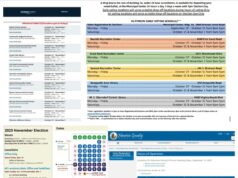by Sam Shirazi
The first day of early voting on September 20 saw record turnout, with over 56,000 Virginians casting a ballot. Since then, daily early voting numbers have gone down, but is still seeing a steady stream of over 20,000 people voting each day in-person and thousands of mail ballots being processed.
It is natural to want to compare early voting numbers to the last presidential election and see what that might tell us about this election. Moreover, given that prior to 2020 Virginians needed as excused to vote early, which Democrats changed to the current universal early voting, 2020 really is the only presidential year that can be used as a comparison.
There have been various reports and analysis that after the initial surge, early voting is “down” in Virginia compared to 2020. Yet it can be unhelpful to make the comparison if the right caveats and qualifications are not explained. There have been some not properly giving full context, either because of unfamiliarity with Virginia early voting patterns or intentionally trying to push a narrative.
But by understanding what happened in 2020, since then, and what is happening in 2024, we can get a sense for what’s actually going on. That will in turn give us clues about what might happen on November 5, although early vote information cannot tell us who will win.
Virginia Early Voting in 2020
The 2020 presidential election was highly unique in that it occurred during the height of a once-in-a-century pandemic and concerns about COVID. This caused many voters, particularly Democrats, to vote by mail, with over 1 million being cast this way in Virginia.
At the same time, in-person early voting was still the dominant form of voting, with almost 1.8 million early in-person votes and over 1.6 million on election day. This was a big change from any Virginia election in history, given the majority of votes were cast early either by mail or in-person.
The vast majority of mail votes were cast for Democratic candidates, and Democrats also enjoyed a smaller edge in in-person early votes. The majority of votes cast on Election Day were for Republican candidates. This reflected both Democratic concerns about voting in-person and Republican concerns about mail ballots.
As a result, 2020 presented some very interesting voting patterns, but also was a snapshot in time during a unique historical moment. Voting patterns both in Virginia and across the country have changed since then, and it’s worth understanding those changes before getting to 2024.
Virginia Early Voting Changes Since 2020
In 2021, then Republican candidate and current Governor Glenn Youngkin made an effort to push early voting among his voters, particularly in-person. This paid dividends for him, as the traditional Democratic edge in early voting was cut down. Youngkin made similar efforts in 2022 and 2023 for Republican candidates, to lesser effect.
At the same time, diminishing concerns about COVID meant that Democrats were more likely to vote again in-person, particularly on election day. So in Virginia, there has been a relative depolarization of voting methods compared to 2020, with Republicans voting more early in-person and Democrats voting more on election day than they did in 2020. This has reduced the gap between early voting and election day, in terms of which side votes more heavily one way or another. The one area where there is still polarization over voting is mail, where Democrats still have about a 2-1 advantage.
In 2023, the push for Republicans to vote early appears to have led to “cannibalization” for Republicans of election day votes, because there was so much more in-person early voting. Youngkin and his team felt their early voting efforts were going to pay off, but many Republicans just largely shifted from voting on election day to early in-person. In the end, Democrats won narrow majorities in both houses of the Virginia General Assembly, showing that early voting is not always predictive of overall outcome.
The Flawed Comparison of 2020 and 2024
These patterns are continuing in 2024, with Republicans voting more early in-person as compared to 2020. Democrats are also more likely to vote early in-person and less by mail this year. While Democrats have traditionally emphasized early voting, there has been a big shift in how Republicans approach it compared in 2020.
That year, former President Trump strongly discouraged early voting, particularly by mail, leading to a much larger number of Republicans casting ballots on election day itself. Since then, Trump has somewhat changed his tune, at least with in-person early voting, to encourage (or at least not discourage) Republicans to vote that way. Youngkin has also pushed the Virginia GOP to move towards more early voting in every election since 2021.
So it is natural that Republican early voting would be “up” compared to 2020, because the floor was so low to begin with. It’s not that Democratic early voting has gone “down,” but that Republicans have started to catch up, at least with in-person early voting. However, that does not mean this shift actually tells us anything meaningful about who will win.
Moreover, the premise of the 2020 comparison and early voting being “down” is also flawed, because Virginia is seeing a lot of early voting, close to 400,000 votes as of writing. This is almost half of last year’s entire early voting number, with over a month to go until the election.
Every election is different, and voting patterns change, especially given how unique 2020 was with the COVID pandemic. The fact that numbers are different this time around is not surprising, so instead the focus should be on the large numbers of voters who are casting ballots now and who will be going forward.
What to Expect During the Rest of Virginia Early Voting
Currently, early voting is in a bit of a holding pattern after the initial surge of early votes, with a relative slowly and steady number of ballots coming in. However, as October goes on, the numbers will continue to rise until they will reach very large totals right before the election for a number of reasons.
Most voters can only currently vote at their local election office, with only a handful of other satellite voting locations open. For example, in the large localities of Prince William, Loudoun, and Virginia Beach, there is only one place to currently early vote – and many voters are not going to take the time to travel a far distance (or battle traffic – or both) when they can just wait for a closer location to open.
Many satellite early voting locations are not going to open until later in October, which will make early voting easier to many more people. Moreover, there is required early voting on the last two Saturdays before the election, and these days always see much more early voting given those who have to work during the week. Finally, some localities also offer extended voting hours and Sunday voting later in October, further making it easier to vote.
Finally, more mail ballots will be returned and processed the closer we get to the election and voters feel the urgency of returning them. Also keep in mind that there tends to be a lag in processing mail ballots, particularly in larger localities, so the current early vote numbers don’t exactly capture everyone who has already voted.
What It All Means
Hundreds of thousands of Virginians have already early voted and the number will be in the millions by the time early voting has ended. This is a testament to both the expanded options of early voting, passed thanks to Democrats, and the interest in this year’s elections.
Early voting can help drive overall turnout because it reduces lines on election day, encouraging more people to vote. Moreover, campaigns obviously do not have to worry about getting out early voters because they have already voted. Instead, they can focus on less-likely voters, such as young people, who tend to wait until the last minute and vote on election day.
At the same time, a voter who casts a ballot early cannot vote on election day so is taken out of pool of voters. Every vote banked early means there is a smaller universe of voters who may show up on election day. It also locks in voters who might be swayed by late developments in a campaign.
So all that is to say that it is not worth reading too much into the Virginia early voting numbers other than people are turning out. There are various other metrics such as Virginia polls, national polls, other state polls, campaign spending, and candidate visits to measure the overall state of things in Virginia.
All those metrics currently point to a healthy Harris lead probably close to Biden’s 2020 margin of 10 points in Virginia. The early vote numbers largely help show a shift in voting patterns, but cannot tell us much about who will eventually win. Instead of obsessing about the minutia of Virginia early voting date, it is more helpful to focus on the stakes of the election and help get out the vote.













